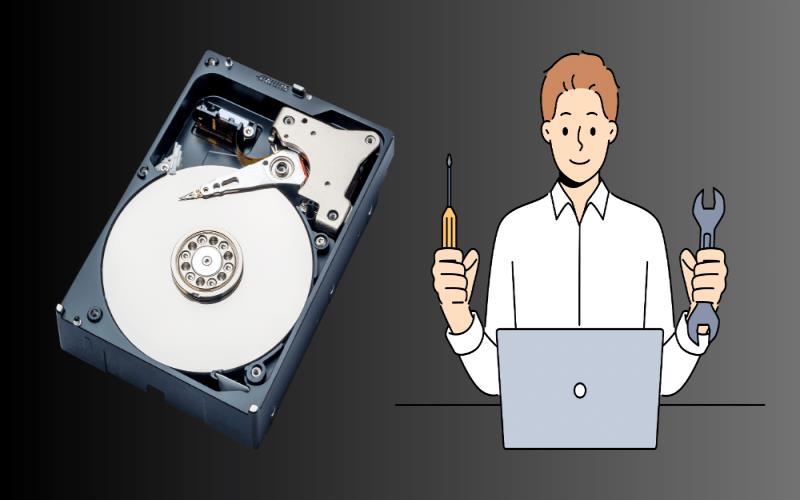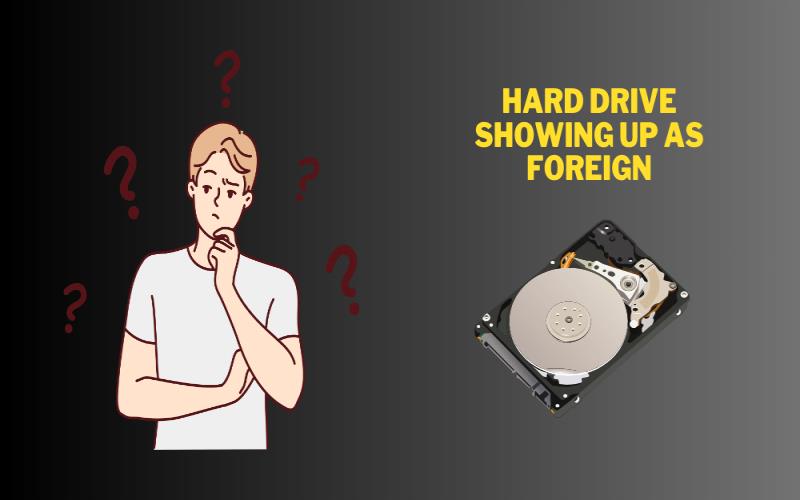When you connect a hard drive to your computer, and the operating system fails to recognize or mount it properly, the drive may appear as “foreign” or “unreadable.” This issue can arise when the file system or partition format of the drive is incompatible with your computer’s operating system or when the drive has become corrupted or damaged.
Seeing a hard drive listed as “foreign” can be frustrating, especially if the drive contains important data. This problem can occur due to various reasons, such as incorrect partition formats, file system incompatibilities, physical damage to the drive, or logical corruption caused by improper ejection or power loss. Understanding the underlying causes and taking appropriate troubleshooting steps is crucial to resolving the issue and potentially recovering your data.
Understanding File Systems and Partitions
-
File systems (NTFS, FAT32, exFAT, etc.)
File systems are the methods used by operating systems to organize, store, and manage data on a storage device, such as a hard drive or a solid-state drive (SSD). Different file systems have their own strengths, limitations, and compatibility requirements. Some common file systems include:
– NTFS (New Technology File System): The primary file system used by modern versions of Windows.
– FAT32 (File Allocation Table 32): An older file system supported by both Windows and macOS, but with limitations on maximum file size and partition size.
– exFAT (Extended File Allocation Table): A modern file system compatible with Windows, macOS, and Linux, designed to overcome the limitations of FAT32.
– HFS+ (Hierarchical File System Plus): The primary file system used by macOS, although it is also compatible with some versions of Windows through third-party drivers.
File systems define how data is organized and stored on a drive, including the structure of directories, file naming conventions, and metadata management. Each file system has its own set of rules and limitations, such as maximum file size, partition size, and supported characters in file and folder names.
-
Partitions
A partition is a logical division of a storage device, such as a hard drive or an SSD, that functions as an independent unit. Each partition can have its own file system and can be treated as a separate logical drive by the operating system.
Partitioning allows you to divide a single physical hard drive into multiple logical drives, each with its own file system and storage capacity. This can be useful for organizing data, separating operating systems, or accommodating different file system requirements. For example, you might have one partition formatted with NTFS for Windows, and another partition formatted with HFS+ for macOS on the same physical drive.
In the next section, we’ll explore the common causes of a hard drive appearing as “foreign” and the steps you can take to troubleshoot and potentially resolve the issue.
Common Causes of a Foreign Hard Drive
-
Incorrect partition format
-
Mismatch between the partition format and the operating system
One of the most common reasons for a hard drive appearing as “foreign” is a mismatch between the partition format and the operating system you’re using. Each operating system has its own native file system and partition format that it can read and write to without any additional software or drivers.
-
Examples: NTFS partition on a Mac, HFS+ partition on Windows
For example, if you attempt to connect a hard drive formatted with the NTFS file system (commonly used by Windows) to a Mac running macOS, the drive will appear as “foreign” because macOS does not natively support writing to NTFS partitions. Similarly, if you try to access an HFS+ formatted drive (the default file system for macOS) on a Windows computer without additional software, the drive will be unreadable and marked as “foreign.”
Corruption or Damage
-
Physical damage to the hard drive
Physical damage to a hard drive can also cause it to appear as “foreign” or unreadable. This could be due to accidental drops, exposure to strong magnetic fields, or general wear and tear over time. Physical damage can corrupt the drive’s firmware, partition table, or file system structures, making it unrecognizable to the operating system.
-
Logical corruption due to improper ejection or power loss
Even without physical damage, a hard drive can become logically corrupted due to improper ejection or unexpected power loss. This can result in incomplete write operations, file system inconsistencies, or damage to the partition table, leading to the drive being recognized as “foreign” when reconnected.
Incompatible File System
-
Newer file systems not recognized by older operating systems
As new file systems are introduced, older operating systems may not have built-in support for them, causing compatibility issues. This can result in drives with newer file systems appearing as “foreign” on older systems.
-
Example: exFAT partition on an older Windows version
For instance, the exFAT file system, designed to overcome the limitations of FAT32, is not natively supported by older versions of Windows, such as Windows XP or Vista. If you connect an exFAT-formatted drive to an older Windows system, it may show up as “foreign” or unreadable.
Understanding these common causes can help you troubleshoot and potentially resolve the issue of a hard drive appearing as “foreign.” In the next section, we’ll explore some troubleshooting steps you can take to attempt to access the data on the drive.
Troubleshooting Steps

-
Check the partition format
-
Using disk management tools (Disk Utility on Mac, Disk Management on Windows)
The first step in troubleshooting a disk dynamic foreign is to identify the partition format and file system it’s using. Both macOS and Windows provide built-in disk management tools for this purpose:
On Mac, open the Disk Utility application (found in /Applications/Utilities). Select the foreign drive from the left pane, and the partition format and file system will be displayed in the right pane.
On Windows, open the Disk Management utility (search for “Create and format hard disk partitions” in the Start menu). The foreign drive will be listed, and you can right-click on it to view its properties, including the partition format and file system.
-
Identifying the partition format and file system
Once you’ve identified the partition format and file system, you can determine if it’s compatible with your operating system or if additional software/drivers are required to access the drive.
Attempt to repair the drive
-
Using built-in disk repair tools (CHKDSK on Windows, Disk Utility on Mac)
If the partition format and file system are compatible with your operating system, the next step is to attempt to repair any logical corruption or inconsistencies on the drive.
On Windows, you can use the CHKDSK (Check Disk) utility. Open the Command Prompt as an administrator, type “chkdsk [drive letter]: /f /r” (without quotes), and press Enter. This will scan the drive for errors and attempt to repair any issues found.
On Mac, you can use the Disk Utility’s First Aid feature. Select the foreign drive, click the “First Aid” button, and follow the prompts to verify and repair the drive.
-
Third-party data recovery software
If the built-in repair tools are unsuccessful, or if the drive is severely corrupted or physically damaged, you may need to use third-party data recovery software. These tools can scan the drive at a deeper level and potentially recover data from corrupted or damaged partitions.
Reformat the drive
-
Backup data first (if possible)
If all attempts to repair the drive fail, or if the partition format is incompatible with your operating system, you may need to reformat the drive. However, before doing so, it’s crucial to backup any important data that may still be accessible on the drive using third-party data recovery software or by connecting the drive to a compatible system.
-
Formatting the drive to a compatible file system and partition format
Once you’ve backed up any salvageable data, you can reformat the drive to a file system and partition format that is compatible with your operating system.
On Windows, open Disk Management, right-click on the foreign drive, and select “Format.” Choose a compatible file system (e.g., NTFS or exFAT) and complete the formatting process.
On Mac, open Disk Utility, select the foreign drive, click the “Erase” button, and choose a compatible file system (e.g., APFS or HFS+) to format the drive.
By following these troubleshooting steps, you can often resolve the issue of a foreign hard drive and regain access to your data. However, it’s always recommended to have regular backups to avoid data loss in case of drive failure or corruption.
Prevention and Best Practices
To prevent logical corruption and ensure data integrity, it’s crucial to properly eject external hard drives before disconnecting them from your computer. Failure to do so can result in incomplete write operations, which can lead to file system inconsistencies and potential data loss.
On Windows, right-click on the drive icon in File Explorer and select “Eject.” On Mac, click the “Eject” icon next to the drive in the Finder sidebar or drag the drive icon to the Trash (this only unmounts the drive, not deletes data).
When formatting or partitioning a new drive, ensure that you choose a file system and partition format that is compatible with the operating systems you plan to use the drive with. This will prevent compatibility issues and the drive appearing as “foreign” on certain systems.
Despite taking preventive measures, hard drives can still fail or become corrupted. Therefore, it’s essential to regularly back up your important data to a separate storage medium, such as an external hard drive, cloud storage, or a network-attached storage (NAS) device. This way, you can recover your data in case of drive failure or corruption.
Physical damage is another common cause of hard drives appearing as “foreign.” To minimize the risk of physical damage, handle drives with care, avoiding drops, excessive vibrations, and exposure to strong magnetic fields. Additionally, store drives in a safe and controlled environment, away from extreme temperatures, moisture, and dust.
Conclusion
In this article, we explored the issue of hard drives appearing as “foreign” and the various causes behind it, including incompatible file systems, partition formats, corruption, and physical damage. We then provided step-by-step troubleshooting methods, such as checking partition formats, attempting repairs, and reformatting drives as a last resort.
One of the most important takeaways from this article is the importance of regularly backing up your data and practicing proper drive maintenance. Even with the best preventive measures, hard drives can still fail, and data loss can be devastating, especially for important personal or professional files.
By following the best practices outlined in this article and staying informed about data management and recovery techniques, you can minimize the risk of encountering foreign hard drives and potential data loss.

